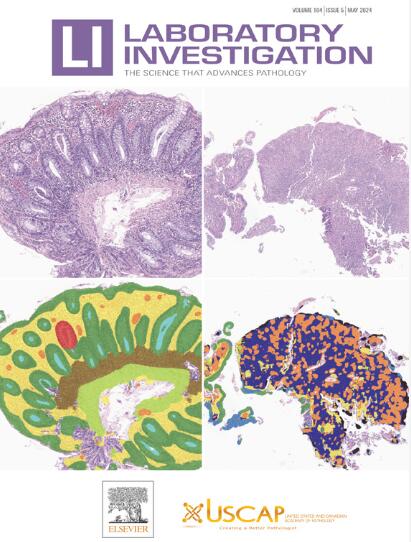Deep Learning–Based Retinoblastoma Protein Subtyping of Pulmonary Large-Cell Neuroendocrine Carcinoma on Small Hematoxylin and Eosin–Stained Specimens
IF 4.2
2区 医学
Q1 MEDICINE, RESEARCH & EXPERIMENTAL
引用次数: 0
Abstract
Molecular subtyping of pulmonary large-cell neuroendocrine carcinoma (LCNEC) based on retinoblastoma protein (pRb) expression may influence systemic treatment decisions. Current histomorphologic assessments of hematoxylin and eosin–stained tissue samples cannot reliably differentiate LCNEC molecular subtypes. This study explores the potential of deep learning (DL) to identify histologic patterns that distinguish these subtypes, by developing a custom convolutional neural network to predict the binary expression of pRb in small LCNEC tissue samples. Our model was trained, cross-validated, and tested on tissue microarray cores from 143 resection specimens and biopsies from 21 additional patients, with corresponding immunohistochemical pRb status. The best-performing DL model achieved a patient-wise balanced accuracy value of 0.75 and an area under the receiver operating characteristic curve value of 0.77 when tested on biopsies, significantly outperforming the hematoxylin and eosin–based subtype classification by lung pathologists. Explainable artificial intelligence techniques further highlighted coarse chromatin patterns and distinct nucleoli as distinguishing features for pRb retained status. Meanwhile, pRb lost cases were characterized by limited cytoplasm and morphologic similarities with small cell lung cancer. These findings suggest that DL analysis of small histopathology samples could ultimately replace immunohistochemical pRb testing. Such a development may assist in guiding chemotherapy decisions, particularly in metastatic cases.
基于深度学习的肺大细胞神经内分泌癌小苏木精和伊红染色标本的pRb分型。
基于视网膜母细胞瘤蛋白(pRb)表达的肺大细胞神经内分泌癌(LCNEC)分子分型可能影响全身治疗决策。目前苏木精和伊红(H&E)染色组织样本的组织形态学评估不能可靠地区分LCNEC分子亚型。本研究通过开发定制的卷积神经网络来预测小样本LCNEC组织中pRb的二进制表达,探索深度学习(DL)识别区分这些亚型的组织学模式的潜力。我们的模型经过训练、交叉验证,并在来自143个切除标本和21个其他患者的活检组织的组织微阵列核心上进行了测试,并具有相应的免疫组织化学pRb状态。当在活检中测试时,表现最好的DL模型达到了0.75的患者平衡精度和0.77的ROC-AUC,显著优于肺病理学家基于h&s的亚型分类。可解释的人工智能技术进一步强调了粗染色质模式和独特的核仁是pRb保留状态的显著特征。同时,pRb丢失病例的特点是细胞质有限,与小细胞肺癌的形态学相似。这些发现表明,小组织病理学样本的DL分析最终可能取代免疫组织化学pRb检测。这种发展可能有助于指导化疗决策,特别是在转移病例中。
本文章由计算机程序翻译,如有差异,请以英文原文为准。
求助全文
约1分钟内获得全文
求助全文
来源期刊

Laboratory Investigation
医学-病理学
CiteScore
8.30
自引率
0.00%
发文量
125
审稿时长
2 months
期刊介绍:
Laboratory Investigation is an international journal owned by the United States and Canadian Academy of Pathology. Laboratory Investigation offers prompt publication of high-quality original research in all biomedical disciplines relating to the understanding of human disease and the application of new methods to the diagnosis of disease. Both human and experimental studies are welcome.
 求助内容:
求助内容: 应助结果提醒方式:
应助结果提醒方式:


